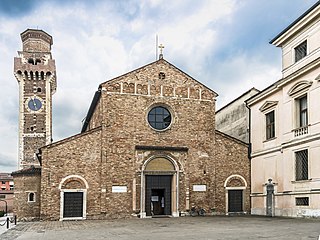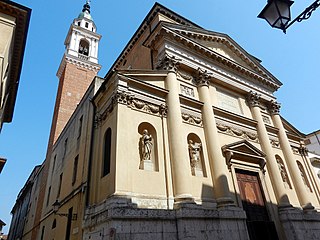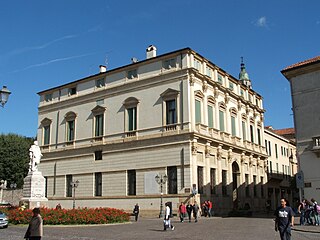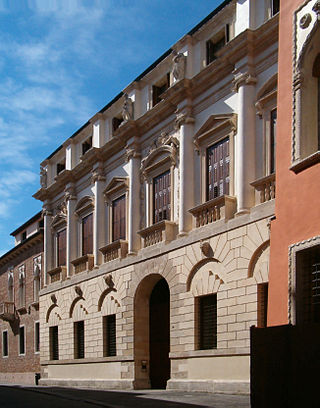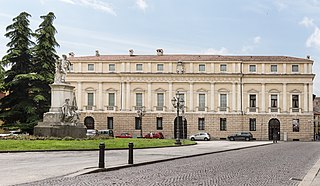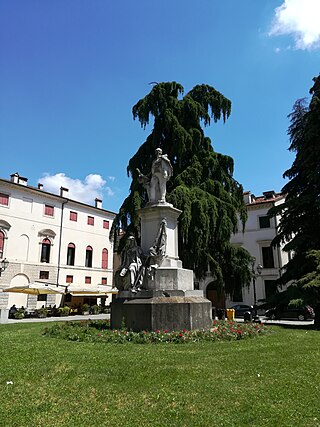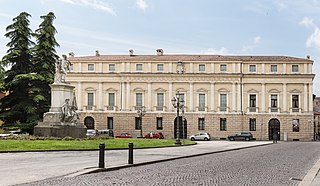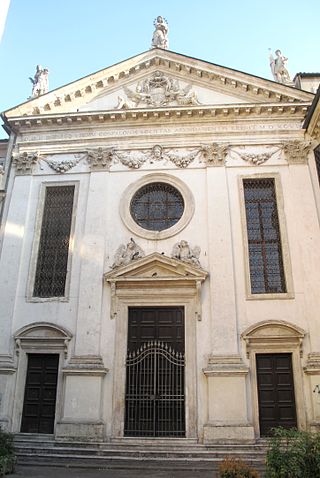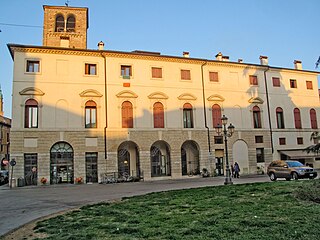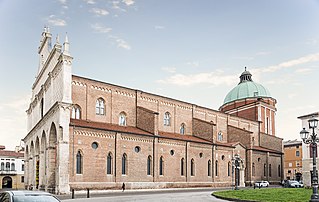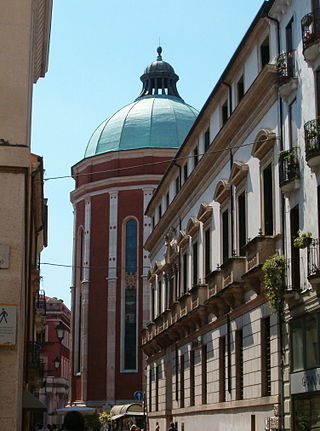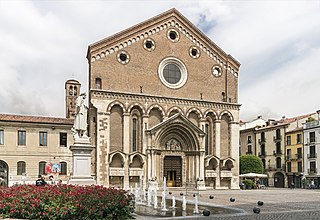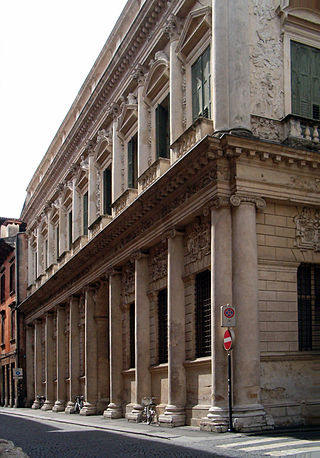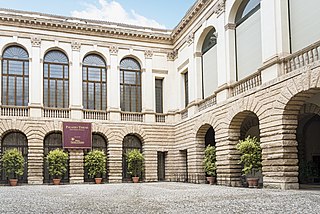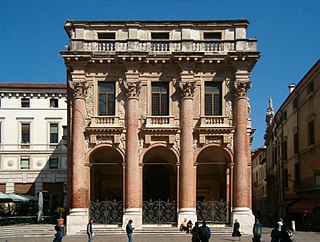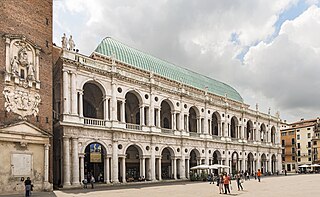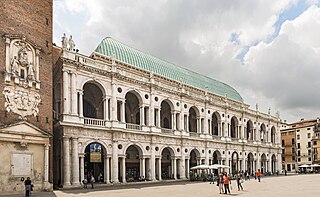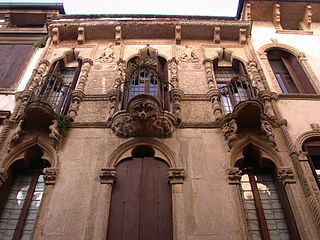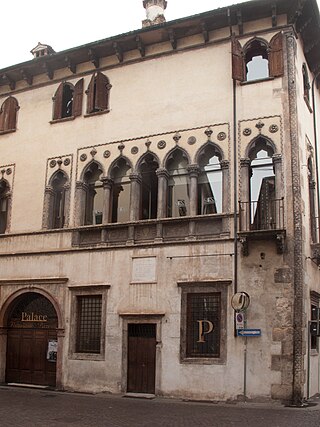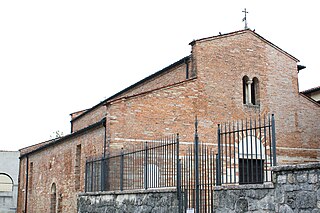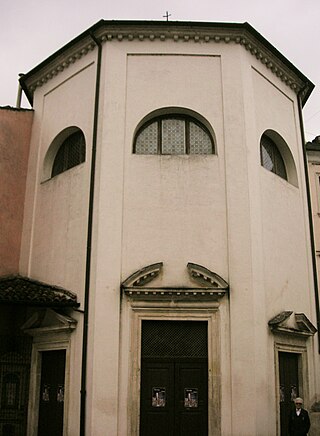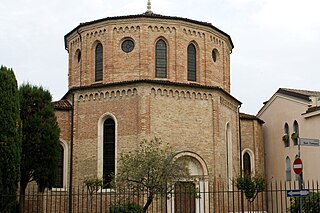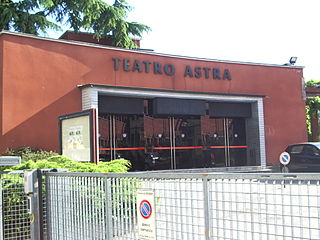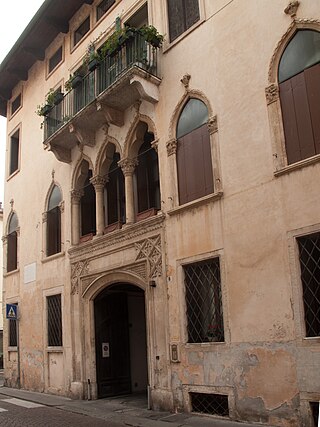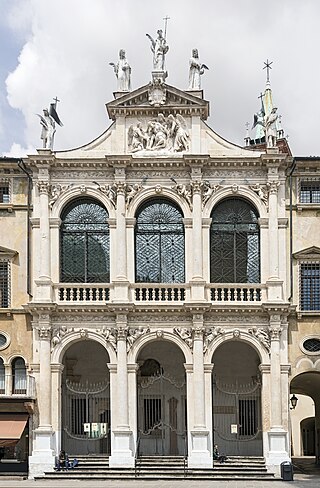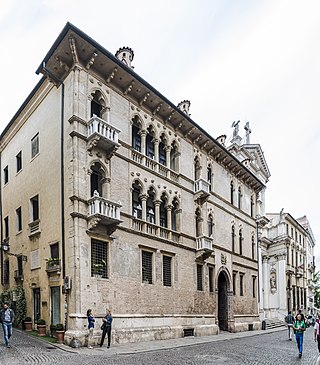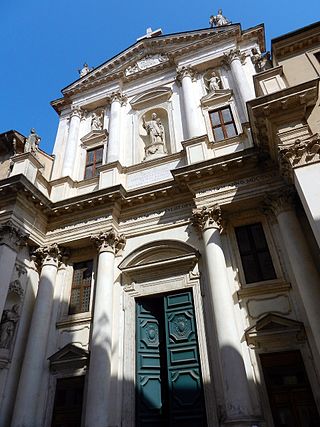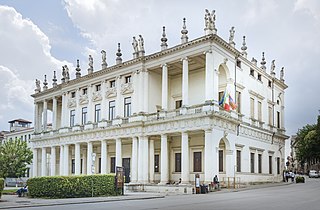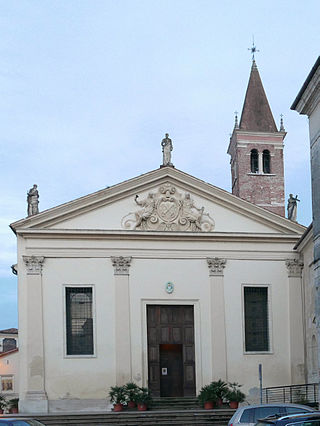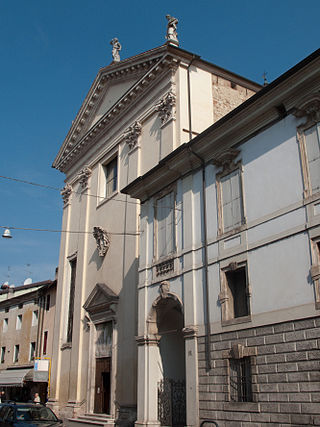Self-guided Sightseeing Tour #3 in Vicenza, Italy
Legend
Guided Free Walking Tours
Book free guided walking tours in Vicenza.
Guided Sightseeing Tours
Book guided sightseeing tours and activities in Vicenza.
Tour Facts
6.6 km
95 m
Experience Vicenza in Italy in a whole new way with our free self-guided sightseeing tour. This site not only offers you practical information and insider tips, but also a rich variety of activities and sights you shouldn't miss. Whether you love art and culture, want to explore historical sites or simply want to experience the vibrant atmosphere of a lively city - you'll find everything you need for your personal adventure here.
Activities in VicenzaIndividual Sights in VicenzaSight 1: Chiesa Santi Felice e Fortunato
The Basilica of Saints Felice and Fortunato is a church in Vicenza, Italy, whose origin dates back to the IV-V century. its current Romanesque appearance is essentially due to the reconstruction of the twelfth century and the restorations of the twentieth century.
Sight 2: Chiesa di San Filippo Neri
San Filippo Neri, also called the Chiesa dei Filippini or San Marcello in San Filippo Neri, is a Neoclassical-style, Roman Catholic church located on Corso Palladio #35 in the city of Vicenza, region of Veneto, Italy.
Sight 3: Palazzo Thiene Bonin Longare
Palazzo Thiene Bonin Longare is a patrician palace in Vicenza, northern Italy, designed by Italian Renaissance architect Andrea Palladio, probably in 1572, and built after Palladio's death by Vincenzo Scamozzi. It is one of the city palazzi of the Thiene family that Palladio worked upon, the other being Palazzo Thiene in the near contrà Porti.
Sight 4: Monumento Giuseppe Garibaldi
The monument to Garibaldi is a sculpture located in Piazza del Castello in Vicenza and is the work of the sculptor Ettore Ferrari. It was inaugurated on August 21, 1887.
Sight 5: Palazzo Porto
The Palazzo Porto is a palace in Piazza Castello, Vicenza, northern Italy. It is one of two palazzi in the city designed by Andrea Palladio for members of the Porto family. Only two bays of it were ever built, beginning shortly after 1571. Why the patron, Alessandro Porto, did not continue with the project is not known.
Sight 6: Museo diocesano
The Diocesan Museum of Vicenza preserves the most precious and significant works and documents the historical, artistic and cultural path of the Vicenza Church. The museum is set up in the Bishop's Palace, built at the end of the twelfth century and expanded over the centuries, but which owes its current appearance to the interventions of the nineteenth century and the second post-war period.
Sight 7: Monumento Vittorio Emanuele II
The monument to Vittorio Emanuele II is located in Vicenza, in Piazza Duomo.
Sight 8: Palazzo vescovile
The Bishop's Palace, or Bishopric, is a large and historic palace in Vicenza, once the seat of the bishop and still of the Diocesan Museum, which overlooks the Piazza del Duomo, a few meters from the Cathedral of Santa Maria Annunciata.
Sight 9: Oratorio del Gonfalone
The Oratory of the Gonfalone is an oratory built in the sixteenth and seventeenth centuries and located in Vicenza in Piazza Duomo.
Sight 10: Palazzo delle Opere Sociali
The Palazzo delle Opere Sociali is a venue used for events and conferences, located in Piazza Duomo 2 in Vicenza.
Sight 11: Cattedrale di Santa Maria Annunciata
Vicenza Cathedral is a Roman Catholic cathedral in Vicenza, Veneto, northern Italy. It is the seat of the Bishop of Vicenza, and is dedicated to the Annunciation of the Virgin Mary.
Sight 12: Palazzo Trissino Trento
Palazzo Trissino al Duomo is a large building located in via Cesare Battisti 10 in Vicenza, commissioned by Pier Francesco Trissino to Vincenzo Scamozzi in 1577 and later enlarged by Giambattista Albanese in 1621-1622 for Achille Trissino, grandson of the founder. The façade has remained a fine example of Renaissance architecture, while much of the interior decoration has been lost. Subject to historical and artistic architectural constraints since 25 May 1960, it has been the headquarters of a bank since 1906.
Sight 13: Palazzo Valmarana
Get Ticket*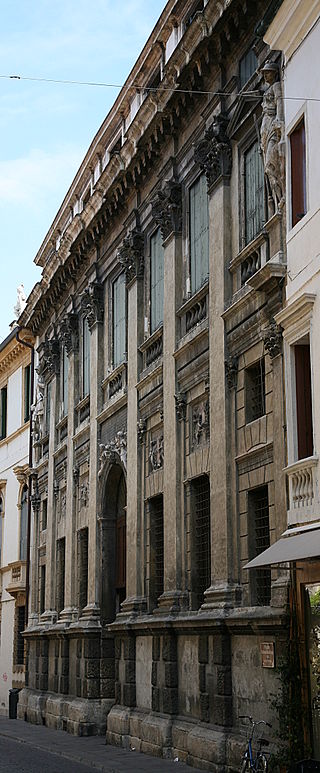
Palazzo Valmarana is a palace in Vicenza. It was built by Italian Renaissance architect Andrea Palladio in 1565 for the noblewoman Isabella Nogarola Valmarana. Since 1994 it is part of the UNESCO World Heritage Site "City of Vicenza and the Palladian Villas of the Veneto".
Sight 14: Chiesa di San Lorenzo
The church of San Lorenzo is a Catholic place of worship in Vicenza, built at the end of the thirteenth century in Gothic style, in its Lombard-Po Valley version of the thirteenth century. It is located in the central Piazza San Lorenzo, along Corso Fogazzaro, and was officiated by the Conventual Franciscans until 2017.
Sight 15: Palazzo Barbaran da Porto
Palazzo Barbaran da Porto is a palazzo in Vicenza, Italy designed in 1569 and built between 1570 and 1575 by Italian Renaissance architect Andrea Palladio.
Sight 16: Palazzo Thiene
Palazzo Thiene is a 15th-16th-century palace in Vicenza, northern Italy, designed for Marcantonio and Adriano Thiene, probably by Giulio Romano, in 1542, and revised during construction from 1544 by Andrea Palladio.
Sight 17: Palazzo del Capitaniato
The palazzo del Capitaniato, also known as loggia del Capitanio or loggia Bernarda, is a palazzo in Vicenza, northern Italy, designed by Andrea Palladio in 1565 and built in 1571 and '72. It is located on the central Piazza dei Signori, facing the Basilica Palladiana.
Sight 18: Basilica Palladiana
Get Ticket*The Basilica Palladiana is a Renaissance building in the central Piazza dei Signori in Vicenza, north-eastern Italy. The most notable feature of the edifice is the loggia, which shows one of the first examples of what have come to be known as the Palladian window, designed by a young Andrea Palladio, whose work in architecture was to have a significant effect on the field during the Renaissance and later periods.
Sight 19: Museo del Gioiello
The Vicenza Jewelry Museum is a civic museum of art and design based in Vicenza, Italy. Located in the Palladian Basilica, it is a museum of jewelry design that preserves the works of jewelry artists such as James Rivière and Giò Pomodoro.
Sight 20: Casa Pigafetta
Get Ticket*Casa Pigafetta, located in Via Pigafetta in Vicenza, is a small building completed in 1481, as the classical inscription engraved above the window on the right of the ground floor meticulously recalls: MCCCCLXXXI / KL AUGUST.
Sight 21: Palazzo Garzadori
Palazzo Garzadori is a fifteenth-century building, located in Contrà Piancoli in Vicenza.
Sight 22: Oratorio di San Nicola
The Oratory of San Nicola da Tolentino is a small chapel-like structure located in Vicenza, Veneto, Italy. It is renowned for its superb collection of 16th and 17th-century paintings.
Sight 23: Chiesa di San Silvestro
The monumental complex of San Silvestro in Vicenza is what remains of the Benedictine monastery probably built in the eighth century and now completely renovated, consisting of the church with three naves with semicircular apses and the monastic area, used in recent times as a university residence, now abandoned following subsidence and cracking of numerous areas of the building, as a result of the 2012 earthquake in Emilia.
Sight 24: Oratorio delle Zitelle
The Oratory of the Zitelle is an oratory built in the mid-seventeenth century for the "Pious House of Santa Maria delle Vergini", also known as the "Hospice of the Zitelle" and located in Vicenza in Contrà Santa Caterina in the area of Borgo Berga.
Sight 25: Chiesa dei Santi Bernardino e Chiara
The church of Saints Bernardino and Clare, commonly known as the church of Santa Chiara, is a religious building in Vicenza, Italy, located in Contrà Santa Chiara, built in Renaissance style at the end of the fifteenth century for the monastery of the same name of the Poor Clares. It is currently a dependency of the Palazzolo Institute of the Sisters of the Poor.
Sight 26: Astra
The Astra Theatre is a theatre in Vicenza built between 1934 and 1936 and owned by the municipality.
Sight 27: Palazzo Volpe Cabianca
The Palazzo Volpe Cabianca is a fifteenth-century building, renovated in the sixteenth century, located in contrà Jacopo Cabianca 8 in Vicenza.
Sight 28: Chiesa di San Vincenzo
The church of San Vincenzo is a historic Catholic place of worship in Vicenza, whose construction with subsequent extensions goes from the end of the fourteenth to the first half of the eighteenth century. The façade overlooks Piazza dei Signori, in front of the Palladian Basilica, and is inserted in the center of the Palazzo del Monte di Pietà, interrupting its uniform texture.
Sight 29: Ca' d'Oro
Palazzo Caldogno Dal Toso Franceschini Da Schio, better known as Ca' d'oro, is a noble palace in Vicenza, Italy, located along Corso Palladio, next to the Church of San Gaetano.
Sight 30: Chiesa di San Gaetano da Thiene
San Gaetano is a Roman Catholic church located on Corso Palladio #147 in the city of Vicenza, region of Veneto, Italy.
Sight 31: Palazzo Chiericati
Get Ticket*The Palazzo Chiericati is a Renaissance palace in Vicenza, designed by Andrea Palladio.
Sight 32: Chiesa di San Pietro
The church and monastery of San Pietro, which gave its name to the homonymous village in the city of Vicenza, until 1810 were the main and managerial headquarters of the abbey of San Pietro, the oldest and most powerful Benedictine women's settlement in the Vicenza area. The church has become the parish seat, while the former monastery is used as a care institution for the elderly.
Sight 33: Chiesa di San Giuliano
The church of San Giuliano is a religious building in Vicenza, Italy. Built on previous buildings in the last years of the seventeenth century, it is located in Corso Padova, 57. Nearby - and in communication with it - is the Salvi Institute, which occupies the buildings of the convent once annexed to the church.
Share
How likely are you to recommend us?
Disclaimer Please be aware of your surroundings and do not enter private property. We are not liable for any damages that occur during the tours.
GPX-Download For navigation apps and GPS devices you can download the tour as a GPX file.
